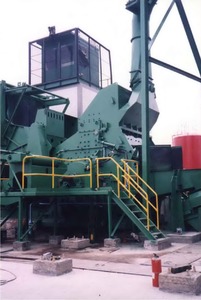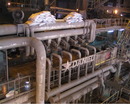98013
二手汽車粉碎機
Car Shredding System-98013
規格介紹:Car Shredding System-98013
Used Lindemann 1/1250 STV Car Shredding System
& Non-Ferrous System
For Scrap Car
50t/h
Project: #98013
Used Lindemann 1/1250 STV Car Shredding System & Non-Ferrous System For Scrap Car
- 1. Built in 2000 and still running now.
- 2. Capacity of specification: 18~32T/Hr… (This is Lindemann’s ) But now the capacity of user is about 50T/Hr.
- 3. System included
Lindemann 1/1250STV Shredding System & Non-ferrous System (Durable Equipment)
1.1 In-feed conveyor
1.2 Control System
1.3 Double roll compression feeder
1.4 1/1250STV Shredder
1.5 Vibration Absorbing System
1.6 Dedusting system 120.000m³/Hr
1.7 Trommel
1.8 Vibrator (Ⅱ)
1.9 Magnetic separator
1.10 Picking conveyor
1.11 Stacking conveyor
1.12 Wet scrubber & water tank
1.13 Conveyor
1.14 Trommel screen
1.15 Overband magnetic separator
1.16 Vibrator(Ⅲ)
1.17 Vibrator(Ⅳ)
1.18 E.C.S. recovery
1.19 Non-ferrous Control Room
- Basic data
4.1 1 (one) nonferrous metal separation plant, Lindemann system, type : NE-5P-BS
For dry magnetic separation and processing of NF-metal and nonmetal mixtures from shredder plant.
Input: 2~6 tons/hour
Depending on the material to be processed
And the percentage of the NF-metal included in the Infeed material. Grain size range of material to be handled: 3~65mm (100mm).
4.2 Capacity of nonferrous metal separator :
Preparation of the nonferrous/nonmetal mixtures from the shredder plant: Separation of screened material (metals - nonmetals)
Grain size Input:
3~12mm 2~3 tons/hour
Rate of reclaimed metals: 93% (without cables and stainless steel) Metal content: 93%
12~30mm 2~4 tons/hour
30~65mm 3~5 tons/hour
Rate of reclaimed metals: 95% (without cables and stainless steel) Metal content: 95%
Preparation of material from heavy-media plants:
Grain size: Input: Magnesium/rubber mixture 12~100mm 2 tons/hour Aluminum/stones mixture 12~100mm 4~5 tons/hour
97% or both end
Separation efficiency:
products.
Aluminum/stones mixture 12~30mm 4~5 tons/hour
30~65mm 5~6 tons/hour
65~100mm 5~6 tons/hour Separation efficiency : 97~98% for both end products . Aluminum/stones mixture 3~12mm 3 tons/hour
4.3 Technical data and scope for supply :
Item 1. Bunker and discharge vibrating conveyor
For continuous, metered feeding of the plant.
Technical data:
Bunker: | Volume :
Feeding height : | approx. 6m³
3000mm |
Vibrating | Feeding opening : | 3000 x 1600mm |
Conveyor: | Trough length : | 4500mm |
| Trough width : Trough height : Power required : | 1100mm
250mm
2 x 1.3KW |
Scope of supply:
- Bunker made of fabricated sheet steel, ribbed, top edge of hopper reinforced.
- Supporting structure with reinforcements and supports for mounting the discharge vibrating conveyor.
- Discharge vibrating conveyor, including drive.
Item 2. Belt conveyor
To transport the material from the bunker to the screening drum.
Technical data:
Shape of belt: Trough shaped Belt width: 650mm Conveying length: 10.0m
Power required: 3.0KW
Scope of supply:
- Belt conveyor, stationary, with drive.
- Feeding chute.
Item 3. Overband magnetic separator:
For magnetic separation of the nonferrous and non-metal material, lifting method of operation.
Technical data:
Belt width: 800mm Belt length: 1672mm Power required: 1.5KW
Energization: 3.1KW, 70VDC Overall width: 1370mm
Belt speed: 1.74m/s
Scope of supply :
- Overband magnetic separator, complete with drive and suspension device for height adjustment.
- Supporting structure for suspending the overband magnet, with material guide chutes (partly of non-magnetic steel).
Item 4. Screening drum
For screening the nonferrous metal/nonmetal mixture into 3. Factions: 0~12mm, 12~65mm, and bigger than 65m.
Technical data:
Drum diameter: 1250mm Drum length: 5000mm Screening length: 3000mm approx. Screening hole diameters: 12mm and 65mm Power required: 3.0KW
Scope of supply:
- Screening drum with exchangeable screening plates, completely covered.
- Frame with drum bearing, drive by gear motor.
- Material guide chutes in the screening zones and at the drum outlet.
- Supporting structure for mounting the drum on the foundation.
- Maintenance platform at the drum outlet.
Item 5. Belt conveyor (sorting belt)
To transport the oversize fraction from the screening drum into containers .
Technical data :
Belt shape: Flat. Belt width: 650mm Conveying length: 10m Power required: 0.75KW
Scope of Supply:
- Belt conveyor, stationary, with drive.
- Feeding chute
- Sorting path, 4000 X 1000 mm.
Item 6. Belt conveyor
To transport the fraction smaller than 12mm into containers . Technical data :
Belt shape : trough shaped Belt width : 400mm Conveying length : 8.0m
Power required : 1.5KW
Item 7. Belt Conveyor
To transport the 12~65mm fraction to the NF-metal separator. Technical data:
Belt shape: conveyor belt with corrugated side walls
Belt width: 650mm Conveying length: 8.6m approx. Power required: 3.0KW
Scope of supply:
- Belt conveyor, stationary, with drive.
- Feeding chute
Item 8. Nonferrous metal separator, complete
Technical data:
Vibrating conveyors : | trough length :
trough width :
trough height : | 1650mm
500/600mm
150mm |
Nonferrous metal separator | power required : | 2 x 0.45KW |
Drive of conveyor belt : | 2.2KW |
|
Drive of magnetic system : | 5.5KW |
|
Item 8. Nonferrous metal separator - continued:Scope of supply :
- NF-metal separator, model NF-5P, complete with drive, separating belt with supports and driving drum with incorporated rotating permanent magnetic system.
- Vibrating conveyor, complete, with drive.
- Supporting structure, completely encased by metal sheet on the separator level, with maintenance platforms and access stairs.
- Material guide chutes underneath the separator.
Item 9. Belt conveyor (sorting belt)
To transport the waste fraction (rubber, wood, glass, stones, plastics) from the nonferrous metal separator into containers (to sort out stainless steel and copper cables).
Technical data:
Belt shape: flat
Belt width: 500mm Conveying length: 7.5m Power required: 0.75m Scope of supply:
- Belt conveyor, stationary, with drive.
- Feeding chute.
- Sorting path, approx. 1500 x 1500mm.
Item 10. Belt conveyor (sorting belt)
To transport the metal concentrate (A1/Sm-mixture) from the nonferrous metal separator into containers (to sort out manually brass and copper).
Technical data:
Belt shape: flat
Belt width: 500mm Conveying length: 7.5m Power required: 0.75KW
Scope of supply:
- Belt conveyor, stationary, with drive.
- Feeding chute.
- Sorting path, approx. 1500 x 1500mm.
Item 11. Electrical equipment
For the control and switching of all motors and devices belonging to our scope of supply.
Technical data:
Max. connected load: 30KW approx. Operating voltage: 440 volts. According to VDE.
Scope of supply:
- Low voltage switch cabinet with 100A main switch including various in-situ control boxes and repair switches for the plant.
- Operating buttons and mimic diagram are installed in the door of the switch cabinet.
- Control is by means of programmable controller, SIMATIC S5-115U, make
Siemens.
- Cabling material from our switch cabinet.
- Material according to VDE instructions.
Table of Models and Output Figures of LINDEMANN Shredder Installations
Shredder type |
Driving power | Internal width of the housing |
Beating circle | Output of Shredder scrap |
| KW (PS/HP) | mm | mm | t/h |
ZERDIRATOR | 370 (500) 550 (750) 750 (1000) |
1600 |
1750 | 6-10 9-18 10-20 |
| 1470 (2000) | 2500 | 2100 | 30-50 |
I | 370 (500) 750 (1000) 920 (1250) |
2600 |
1750 | 9-13 15-25 18-32 |
II | 1470 (2000) 1840 (2500) |
2600 |
2100 | 30-50 35-60 |
III | 2200 (3000) 2940 (4000) |
2940 |
2500 | 40-75 50-100 |
Subject to modification in accordance with the latest technical development.
LINDEMANN Shredder Plants in Operations for the Scrap Industry
Since many tears and in many countries, LINDEMANN Shredder Plants transform complete derelict motor cars, sheared car body scrap (slabs), light bales, and miscellaneous scrap, such as refrigerators, stoves, washing machines, bicycles, and light sheet metal scrap , etc. into clean, dense and small-piece shredded scrap-a valuable raw material for the steel industry. LINDEMANN manufactures complete plants of different sizes designed for output figures from 6 to 150 tonnes per hour, including effective equipment for the charging of the material to be processed as well as for the cleaning, dedusting, and transporting of the shredded products.
When processing derelict cars, one obtains, depending on their composition:
67-75% clean steel scrap
24-30% non-metallic waste
1.0-3.0% non-ferrous metals
Shredded scrap produced by LINDEMANN Shredder Plants has the following features:
y High density
y A specific bulk weight of 1-2.5kg/dm3
y uniform pieces of an average size of 50-150mm
y high quality and cleanness
The non-metallic refuse (rubber, textiles, plastics, wood, dirt, sand, etc.) has an average bulk weight of 0.5 tonnes/m3. Just like household refuse, it is suitable for controlled tipping.
LINDEMANN Machines and Plants for the Scrap Preparation
Car Body Shredder Plants
Shredder Plants for non-ferrous metals
Dross preparation plants Car Body Squeezers Scrap Shears
Scrap Baling Presses Crushers for Turnings Briquetting Presses Cast Iron Breakers
The LINDEMANN Shredder System at a Glance
LINDEMANN Shredder work according to a special system, the main feature of which is the grid-plate arranged above the rotor.
For special requirements, however, a special shredder type “R” with upper grid-plate and additional basket type bottom grid can be supplied.
|
The scheme shows the working method of the LINDEMANN shredder, the working cycles are:
- 1. Automatically controlled feed of charged scrap .
- 2. Tearing-off at the anvil edge .
- 3. Size-reducing at the baffle plate edge .
- 4. Densifying at the baffle plate , at the grid , and by impact with other scrap pieces .
- 5. Exit of shredded scrap pieces through the grid openings .
- 6. Sucking-off of flying dust and waste .
- 7. Discharge of the shredded scrap .
- 8. Ejection of coarse unshreddable pieces .
Advantages of LINDEMANN Shredder Plants
- 1. Low foundation cost .
- 2. Low power consumption due to the smooth housing bottom and the milling-kind tearing effect of the hammers at the anvil edge .
- 3. Insensitivity against coarse pieces which cannot get stuck in the smooth housing bottom and which are ejected through the hydraulically operated ejection door without interruption of the production process .
- 4. High density of shredded scrap due to the scrap pieces rebouncing at the grid , at the baffle plate , and by impact with other scrap pieces .
- 5. Quick exchange of grid by simply pushing out the grid plate side-ways , this is of particular importance if scrap density is to be changed by substituting grids with different grid openings .
- 6. Long “fall” of the shredded scrap pieces from grid exit to shredder exit - which means maximum cleaning effect by means of the connected dust extraction .
- 7. Maximum flywheel energy due to the disc-type rotor , thereby reduction of current peaks during shredding .
- 8. Robust and wear-resistant feeding and charging equipment , scrap feed depending on the power in take of the shredder driving motor , thus , peak current and overcharging of the shredder are avoided , and a high output is achieved .
- 9. Highly wear-resistant lining of all parts of the shredder housing subjected to strong wear with easily exchangeable wear parts .
Disc-rotor with exchangeable wear-resistant wear caps .
Shredder size II , with steel belt feeding conveyor , driving power
1840KW
Shredder size III , driving power
2940KW
Scheme of a Car Body Shredder Plant
- 1. Feeding chute with tilting table.
- 2. Shredder,
- 3. Main drive motor.
- 4. Vibration absorber.
- 5. Hammer dismantling
- 6. Control
- 7. Vibrating conveyor.
- 8. Belt conveyor.
- 9. Separating drum.
10.Magnetic drum.
11.Steel sorting belt.
12.Steel discharge belt.
13.Dust belt.
14.Dust discharge belt.
15.Non-ferrous metal sorting belt.
- Dust extraction equipment.
Here some details
Every detail counts if a shredder plant shall work trouble-free and give highest performance. We know how every detail must be designed and carried out by our experience gained in the construction of many shredder plants.
- 1. The shredder housing is hydraulically tiltable at the rotor centre line to give easy access to the interior of the shredder.
Arrangement can also be made for the rotor to be lifted with the housing top.
- 2. Due to the wear-resistant protection caps fitted to the rotor, build-up welding of the rotor discs is no longer necessary.
- 3. The hydraulic device for dismantling the hammer axles facilitates the exchange of hammers and reduces maintenance
- 4. The control desk is designed for simple and safe control of the whole plant automatic supervision of all electric drives and instruments with indication of their operation on a luminous
- 5. Separating drum with dropping
- 6. Magnetic separating station with following steel sorting conveyor.
- 7. Slewable belt conveyor for the discharge of clean shredded steel scrap on to stockpile or for direct loading into
LINDEMANN Shredder plants Serve the Environmental Protection
They do away with derelict motor cars and ugly mounds of mixed scrap, they work ecologically beneficial, vibration-free, without dust.
By means of noise protection equipment, the noise level can be reduced to values officially prescribed.
- Sound absorbing walls around a shredder plant.
- Vibration absorbing units especially developed for LINDEMANN Shredders prevent the transmission of vibrations and keep foundations costs low.
- Dust extraction equipment developed by LINDEMANN ensures dust-free shredding, conveying, and loading of the shredded products. The degree of purity of the exhaust air complies with all statutory provisions.
Operation instruction
A.1 Introduction
A1.2 Basic information
Materials suitable for shredding
Maximum thickness of material:
For sheet metal plates: 2mm
For sectional steels and pipes: 5mm wall thickness
For rounds: 10mm
Important to note:
Please avoid by all means to only charge material having there maximum dimensions. Such material should be fed into the shredder in small quantities only, most preferably mixed with other light scrap.
Materials unsuitable for shredding
- Wire bales and wire ropes (danger of accident-danger of shredder exit getting chocked and blocked).
- Long flats or strip-shaped sheet-metal sections in a length ranging from approx. 3 meters onward when they are charged in larger quantities (danger of overfeed of shredder).
- Receptacles (containers) or items containing explosive, inflammable, toxic or corrosive substances in liquid, dust-like or gaseous condition (danger of explosion, danger of accident), in particular, keep receptacles or containers from the chemical and colour producing industry away from the shredder, because:
(a) Their content - even if only small residual quantities are involved - in most cases, is highly explosive and toxic.
(b) Because cans (canisters) and receptacles are partly tinned, so that they would increase the tin content of the shredded scrap beyond the admissible limit.
Preferably, the shredder is used for:
- Car bodies
- Stoves, refrigerators, washing machines, steel furniture for offices and similar items.
- Stampings and light destructor scrap (collected light iron scrap).
How to prepare the car bodies:
Car bodies are only allowed to be fed into the shredder after having been prepared in a dequate manner.
The old cars must be freed from the following items: Liquefied petroleum gas tanks
- In view of the highly explosive gas mixture which in case of explosion would lead to damaging of the dust extractor equipments.
Tyres
- Because of their steel liners which cause the various tyre pieces to drop on to the steel scrap conveyor-belt instead of being directed to the waste belt by means of the subsequently operating magnetic drum.
The following elements should be removed from the old cars: Motors and gears
- In view of the high portion of alloyed material the steel mills do not like to find in the ultimate or end products.
- Because of the increased wearing effect in the shredder.
- In view of contamination of the oil (oil mud deposits in the pipe system). Car sets (if the shredder installation does not feature a separating drum)
- On account of the optically seen poor appearance of the shredded scrap, with hooked-on bolster and textile waste.
Note:
Gasoline tanks either have to be removed completely or perforated in such a way that no gasoline remnants are still in them (please refer for this to it, “unsuitable materials for
the shredder”).
Liquefied petroleum gas tanks shall be removed completely because the stuff contained in them would produce a highly explosive gas mixture in the shredder, and as a consequence, the entire dust extractor equipment would be exposed to the danger of damaging (please refer for this also to “how to prepare the car bodies”).
Batteries and radiators have to be removed if not done already by the scrap car suppliers on account of their good sales price.
Car bodies can be processed both in pre-squeezed and unsqueezed condition. Axles, springs and wheels can be shredded together with the car bodies.
So called car body slabs are, in general, not suitable for being shredded because the shredder may be overstressed by them and increased current peaks may occur. In any event, the portion determined for the car body slabs to be processed should remain within a justifiable limit.
Caution:
The shredding of scrap bales is to be strictly excluded coarse items contained in the bales are neither detectable nor can they be removed. Therefore, there would be complete breakdown of the installation on account of rupture caused by coarse items.













